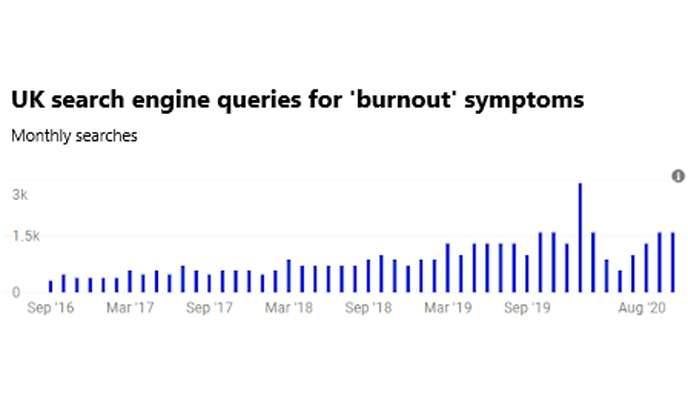Burnout symptoms increase for 24% of UK employees in 2020: January 'burnout spike' predicted

Ahead of National Stress Awareness Day in the UK on Wednesday 4th November, workplace health experts outline why we need to be more prepared than ever to deal with workplace burnout following a steep rise in online searches for symptoms
Research into Google search data revealing online searching habits show that we’re in danger of a January 2021 ‘burnout spike’. Searches online for symptoms with terms such as ‘signs of burnout’ have already increased by 24% throughout 2020 compared to the previous year.
Data shows that last winter saw a record high January ‘burnout spike’, traditionally associated with low mood, depression and demotivation in employees.
Despite the recent peaks, there’s evidence of a consistent yearly increase in searches for symptoms of burnout. Google search data, collected from search volume tool kwfinder.com, highlights a gradual increase in volume of searches for ‘signs of burnout’ over the last four years, culminating in a notable spike in January 2020. On average, total searches have increased by 41% annually since 2017.
Following the disruption of people’s working and personal lives due to coronavirus, HR teams are warned that this spike is expected to be worse in January 2021. Additional support will be needed for stress this winter in order to maintain mental health and productivity.
Global online searches for the term ‘occupational burnout’ have increased by more than 2500% since 2015, and the Covid-19 pandemic is fuelling an even faster rise in work-related mental health issues.
Richard Holmes, Director of Wellbeing at Westfield Health, says: “Burnout is a state of emotional, physical and mental exhaustion caused by excessive and prolonged stress. Pressure at work is usually the main culprit and when budgets are tight and teams are small, people often find themselves with multiple roles and heavy workloads, piling on the stress.
Policies like turning off email servers outside of working hours helps ring fence valuable recovery time. Mental health first aid training can also help managers spot the signs or triggers and put preventions in place.
Contractors or freelancers who don’t have the support of HR might need to adopt their own strategies such as setting working hours, turning off email alerts out of these hours and separating work and living space if working from home.”
What can you do to reduce excessive stress and burnout?
It is clear that understanding of the problem among employers remains relatively low.
Angela Knox, Director of workplace employee wellbeing program Keep Fit Eat Fit, says: “Recognising burnout or excessive stress in employees is a vital part of the HR manager’s work, and one which sadly often gets overlooked. If employers have systems in place that are designed for regular monitoring of each employee then problems can be identified and dealt with before they escalate.
"Opportunities to intervene can easily be missed. In larger companies with higher head counts it is a good idea for the head of HR to have eyes and ears in the various departments so that they can keep track of any key developments or problems before they occur.”
There are plenty of steps that people can take in order to reduce stress and the risk of burnout, and employers can proactively encourage these among their employees.
- Encourage regular exercise. Even the shortest 10-minute brisk walk can have a real impact on mood and motivation; it doesn’t have to be a 10-mile run. Getting away from the desk to exercise in the fresh air has a direct link to increased productivity.
- Ensure employees don’t sit at their desks for too long. Humans are not made to sit for long periods, and a five-minute desk break every hour reduces the risk of injury, refocuses the mind and helps break the monotony of both home and office working – even if it’s just a walk to the kitchen for a cup of tea.
- Encourage quitting unhealthy habits. Poor diet and excessive drinking both have a major impact on a person’s stress levels, as does smoking. In fact, a recent study found that quitting smoking made immediate positive improvements to mental health, especially after the first four weeks.
- Make sure people talk to their line manager. Communication is what prevents those initial feelings of pressure, anxiety or demotivation from becoming mental health problems like burnout. The sooner an employer is aware of the problem, the sooner they can do something about it.
- Set up routine catch-ups with the team. With a large number of employees now working from home, it’s important to keep lines of communication open to keep the social aspect of work. This reduces the feeling of isolation and has positive a impact on wellbeing.
- Promote mental health days. Fostering a workplace culture where people don’t feel guilty for occasionally taking the day off sick – even if they’ve not got a physical illness – will help alleviate longer-term stress and maintain morale.
- Push annual leave. Employees should be encouraged to use all of their holiday allowance each year, even if they’re not going away anywhere. This fosters a healthier work environment and creates a better work-life balance that benefits everybody.
Add your comment

- Administration 1
- Building Design, Planning, Development 1
- Catering 2
- Construction 4
- Contracts, Projects, Bids 2
- Energy Management 1
- Engineering, Maintenance 16
- Estates, Property 5
- Facilities Management (main) 20
- Hard Services 12
- Health & Safety 1
- Management 5
- M&E 3
- Operations 6
- Sales & Marketing 3
- Soft Services 5
- Sustainability 1
- ICT, Technical 5
- Workplace 2


